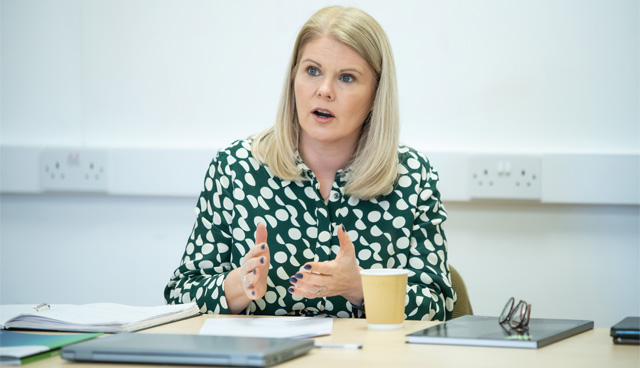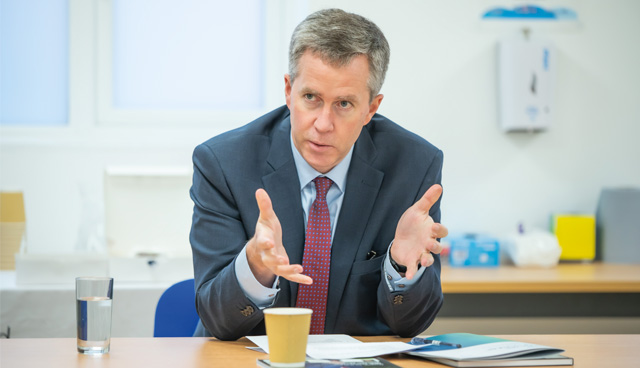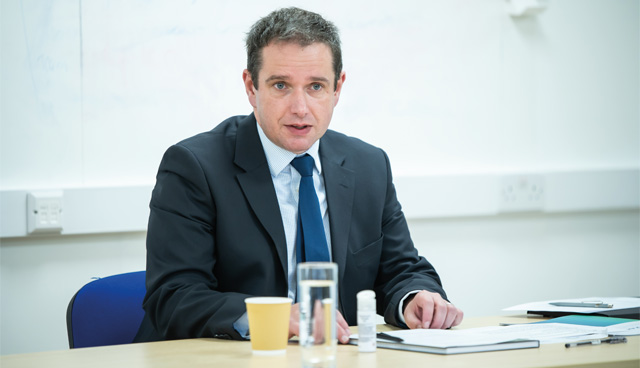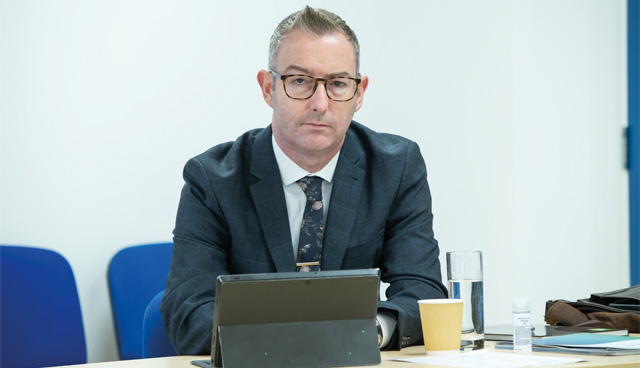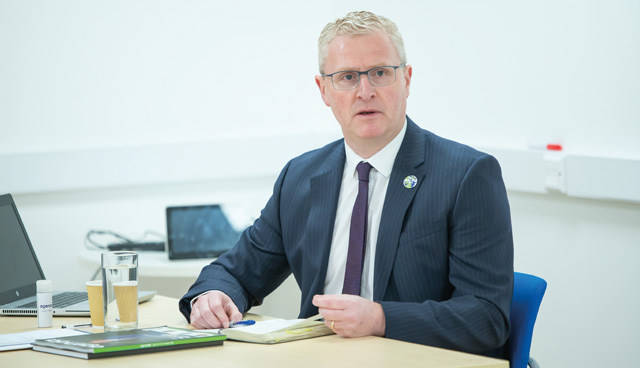The power of water
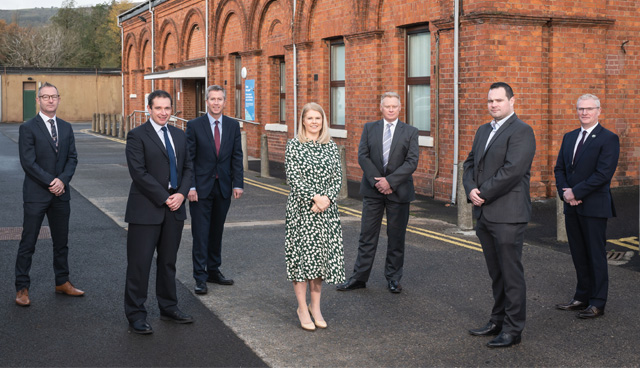
NI Water hosted a round table discussion with key stakeholders in energy and environment about the role of water in creating an affordable, low carbon economy for Northern Ireland.
What is the role of individual organisations in pursuing a net zero, sustainable future?
Sara Venning
At the outset, organisations tended to focus on themselves and mitigating their own carbon footprint, but that outlook has broadened. At NI Water, we came to realise that through working with others, our decarbonisation impact could be much bigger and often, better value. We see our role as setting out the opportunities that exist and while we know it is unlikely that we will be the organisation that brings all of those opportunities to life, we are engaging in making stakeholders aware of them, for the benefit of all customers.
Kevin Hegarty
Every organisation and individual has a role to play in the decarbonisation agenda. While the role of the individual organisation is important, there are massive opportunities for organisations, particularly those large organisations who are collaborating and demonstrating leadership, to be market makers. When you look at areas such as hydrogen, and the innovation already occurring in that space, or low carbon heating solutions being piloted by the Housing Executive, it is evident that collaborative working can present huge opportunities.
Edward Kerr
In trying to create a market for new renewable generation, whether that be hydrogen or biomethane etc, we also recognise that the technology has to develop alongside the market. Yes, government has a role in relation to pilot level projects and seed funding to develop technology in line with demand but a lot of the disruptive technology we may rely on over the next 20 to 30 years to get us to 2050 is still in development. Individual organisations deploying pilot projects at various scales, through various mediums and in various sectors give us the greatest scope to assess how technology settles and how it can be developed. We share a lot of industry with the rest of the UK but at a much smaller scale, so we have an agility that allows us to transition technology more easily.
“Beyond demonstration of the power of collaboration there is also an onus on ensuring it happens and assessing how we can establish a framework in Northern Ireland that either compels us to collaborate or holds us to account for failure to do so.”
— Sara Venning
Jonathan Killiner
Individual organisations have largely been focused on mitigating their own carbon footprint, but I believe more and more, there are now questions being asked of organisations externally. The ecosystem of sustainability is developing rapidly and whether it is in relation to funding, clients or other elements of the business, organisations are now being asked about their own green credentials. We are already seeing banking facilities being predicated on an organisation’s sustainability response and it is interesting to see, in terms of the Power of Water report and a call to arms for organisations around their carbon footprint, how that collaboration might be part of the solution.
Paul Stapleton
NIE Networks is investing £150 million per annum in infrastructure in Northern Ireland, most of which is to enable a sustainable energy system so that clean energy sources can connect and so that customers can avail of the use of clean energy. Organisations have a huge role to play, particularly in relation to leadership. There are challenges. The COP26 conference highlighted the challenge in nations moving in tandem and at the same pace in relation to decarbonisation and locally, producing enabling policy and legislation, has taken time. However, there is a need and an opportunity for organisations to show what is possible and to inspire employees, customers, and society to make the transition.
John French
NI Water’s Power of Water report is a good example of the role organisations have in setting out ambitions and pushing forward as we pursue net zero goals. However, we need the foundations to support those organisations in achieving those goals. I am looking forward to seeing what the new Energy Strategy sets out and the targets within it. The Utility Regulator, as a statutory body, is very clear that good regulation is based around a solid statutory base. We need that statutory base to reflect the net zero future so that we can support organisations in pursuing the net zero goal.
Outline the critical technologies to enable organisations to be part of the climate solution and address the variability gap?
Edward Kerr
Moving beyond the established technologies such as onshore wind, solar photovoltaics (PV) and combined heat and power (CHP), we are focusing on things like hydrogen via electrolysis or steam-methane reforming, linked to carbon capture. Our approach to carbon capture solutions will be different than elsewhere across the UK, for example, where we have seen carbon clusters in Liverpool or Teesside. The reality is we are going to have to utilise different carbon capture techniques and technologies because of the nature of our dispersed industry. It comes back to collaboration; we need to assess what companies are viewing as waste and then examine how that can be utilised elsewhere for increased efficiency. That approach is also going to be key for another potential technology, anaerobic digestion (AD). Above all, however, working towards 100 per cent green power, or as close as possible, must be the standard.
“Our size and our agility present an abundance of opportunity. All the players are here and if we can collaborate together then we can achieve a huge amount.”
— Paul Stapleton
Paul Stapleton
The technology required can be viewed in three broad categories. Firstly, the technology to produce clean energy. These are familiar technologies used to harness the natural resources such as onshore and offshore wind, solar PV, sea power and hydrogen electrolysis. Secondly, we need to focus on technologies that will enable customers to use that clean energy. For example, EV and EV charging infrastructure, heat pumps for domestic homes, smart metering, and the automation of control systems to optimise power use. Thirdly, we need technology to balance the system and to make sure that we have clean energy available when the sun is not shining, and the wind is not blowing. This includes storage and interconnection, in all their various forms and smart demand-response solutions to enable and support consumers to change their energy demands depending on supply.
Sara Venning
Flexibility is very important. While we are excited about emerging technologies and the role we can play in piloting and deploying those technologies, using the publicly owned assets we manage, we are also aware that as a very large user of power, we must show agility in using that power. We have worked closely with EY around harnessing and using our existing data so that, alongside the network provider, we can make use of a load bank to free up capacity for other clean technologies being deployed. I think the Utility Regulator has a big role in regulating how that is done and also incentivising and rewarding agility.
However, we are also aware that there are high levels of curtailment currently and technologies like storage and hydrogen electrolysis are geared towards ensuring that the variability gap is narrowed. How we kickstart and rollout those technologies is something we need to address now if we are to decarbonise energy successfully.
John French
This year has highlighted the importance of policy leavers when the wind does not blow, and the sun does not shine. We have had the lowest levels of wind since 1961 and the most amber alerts in relation to security of supply in any one year over the last decade. As we contemplate what the back-up generation is going to be in a net zero future, we need to be clear about the evidence and analysis around it. There is a lot of hype surrounding certain technologies, but their value has to be proven and we must ensure that domestic and business consumers can afford this new future. How we ensure the lights stay on when the wind does not blow, and the sun does not shine in a net zero future is a question that has yet to be fully answered.
Kevin Hegarty
There is no silver bullet but something I always stress is that strategy, consultation, and engagement has to be translated into action if we are to save even one MT of carbon. The obvious starting point is focusing on those areas with the greatest carbon emissions, for example agriculture (27 per cent) and transport (20 per cent). Additionally, I think it is important that we use this decade to ensure that as assets come forward for replacement, a net zero choice is available. While 2050 is not that far away, we still have enough time to get policies, supply chains and regulatory regimes right to support those decisions. The draft Energy Strategy is set to include a 70 per cent electricity from renewables target by 2030 and it is worth remembering that not that long ago, the prospect of 5 per cent renewable penetration was deemed impossible by some in the energy industry. 70 per cent will be a massive technical and economic challenge and there will be the need for financial investments to deliver this. That is why the right regulation regime and incentivisation of the private sector will be so important in delivering this transition.
Jonathan Killiner
As a technology, I believe hydrogen as a storage medium will be critical, however, I also believe there is work to be done outside of technology. COP26 served as an example of a disconnect between those inside the room and those outside of the room. If we are going to bring society with us on the decarbonisation journey then we must increase efforts in communication, engagement, and persuasion.
How can collaboration transform how we store and generate power?
Paul Stapleton
Collaboration is essential. If you look at the range of ingredients needed for a clean energy project, from source, demand, and site, through to finance, technical capability, and licensing/permitting, no one organisation has all the elements and so we need collaboration to bring these together. The case studies within the NI Water Power of Water report demonstrate well how we can achieve more collectively than we will do individually. Northern Ireland has one Utility Regulator, one water company, one electricity network company, and behind that it has a strong academic and research sector and an indigenous ICT base. Our size and our agility present an abundance of opportunity. All the players are here and if we can collaborate together then we can achieve a huge amount.
Sara Venning
The Power of Water report demonstrates that if we are to achieve a lowest cost, sustainable energy future then the system and network operators have a role to play, policymakers have a role to play, there is a need for financers, innovators, and end users etc. There are so many interconnected but previously siloed organisations that need to come together. Beyond demonstration of the power of collaboration there is also an onus on ensuring it happens and assessing how we can establish a framework in Northern Ireland that either compels us to collaborate or holds us to account for failure to do so.
Edward Kerr
The Energy Strategy work recognises that there is no single solution and that we will need a multifaceted societal consumer led approach across multiple sectors, whilst deploying a diverse range of technologies at varying levels of maturity. That is a challenge, but it is not necessarily a problem. Diversity in energy supplies will assist us in getting to a point where we are a resilient, indigenous clean energy generating region and ultimately break the chain of the price pressures we have seen recently. We will have the benefit of being an open, more collaborative market, leading to a better energy future.
“How we create a market that is attractive to investors but also enables them to trade on when they have appreciated value is something we need to put our minds to.”
— Jonathan Killiner
Jonathan Killiner
In the current markets, there has been an extraordinary amount of money raised and focused on renewables to support the transition. If we are creating a market and wish to entice that investment, to ensure that the cost does not lie solely on the public purse and ultimately, individuals, then we need to ensure there are defined and tradeable opportunities. How we create a market that is attractive to investors but also enables them to trade on when they have appreciated value is something we need to put our minds to.
Kevin Hegarty
It is worth saying that collaboration is something that needs to be worked very hard at and an appetite to collaborate does not mean it will always happen. In delivering the Green Growth Strategy, there is no doubt that the process would have been easier had it been taken forward by a single department and launched by a single minister. However, Minister Poots and the Green Growth team felt very strongly that this needed an Executive-wide approach. It has added challenges, such as increased delivery time and managing the drafting process, but the collaborative impact far outweighs those challenges.
“There is a lot of hype surrounding certain technologies, but their value has to be proven and we must ensure that domestic and business consumers can afford this new future.”
—John French
John French
The size and scale of Northern Ireland means collaboration between the private and public sector is essential to deliver those net zero technologies. Within that, we also need evidence and data to incentivise the right technology. Our geographical location and our natural resources mean that we need to have a greater emphasis on reliable net zero technologies to support the security of supply.
What challenges are posed to utility security and consumer protection while creating a low carbon economy?
John French
Analysis carried out by the Utility Regulator in 2021 shows that a focus on onshore renewables, given their intermittent nature, carries with it risks that by 2030 you could have doubled the cost of energy, increased security of supply problems and failed to make sufficient carbon savings because of the dual system that would be needed for backup load. The policy responses delivered must makes sense in order to avoid such a scenario. We tend to focus on a just transition by 2050 but we have also got to make sure that business and domestic customers can afford the cost of energy from now until then and that we do not inadvertently make energy a luxury good.
Sara Venning
Cost is key. How you decarbonise impacts on price and with every solution we deliver, we must have an eye as to whether people can afford it.
Paul Stapleton
Undoubtedly there will be key challenges of transition in relation to security of supply. However, three key ingredients – greater interconnection, storage and demand-response capability – can give us a secure and reliable energy system. It is a 20 to 30-year journey and on that journey, we need to be conscious of price and affordability for vulnerable consumers. On price, our modelling suggests that the electricity network will require investment of some £1 billion in the next decade, however, the network component of the cost of electricity does not need to be higher than it is today. That is because we are shifting the system away from one where there is a big variable component in fossil fuel cost to one that is more about infrastructure and fixed cost. For the consumer, the focus has to be on total energy costs. I have no doubt my electricity bill will increase but I also expect to make savings in not paying for petrol/diesel or fossil-fuelled heating solutions.
Kevin Hegarty
The Climate Change Committee has told us that Northern Ireland’s contribution to the UK Sixth Carbon Budget involves a large, sustained increase in investment in Northern Ireland, adding around £1.3 billion annually by 2030. While that has yet to be quantified on a sectoral basis, the OBR estimates a 75/25 per cent private/public split, meaning a cost to the public purse of around £300-400 million. Given that we have current headroom of about £1.2 billion per year in terms of a capital budget, there are some very difficult decisions ahead for policymakers. However, on the flip side, we cannot afford not to do this because the cost will be greater in the long term. An interesting concept is around how we monetise the critical elements of a better environment to enable inclusion in the business cases we are producing. Also generally, we use GDP as a metric but taking New Zealand as an example, they have recently decided to parallel monitor their economy based on the “Happiness and Wellbeing Index”. Our current system, largely centred on net present monetary costs, is a difficult one but when you start including other variables such as air quality etc.
“Diversity in energy supplies will assist us in getting to a point where we are a resilient, indigenous clean energy generating region and ultimately break the chain of the price pressures we have seen recently.”
— Edward Kerr
Edward Kerr
Beyond cost, there are the practicalities of a more diverse energy mix to consider such as skill capacity and the levels of reskilling which will be required. Part of this change will be about tempering the potential economic shock associated with such a fundamental transition and price to the consumer will be a big part of the process and delivery.
What policy drivers would best accelerate climate action?
Paul Stapleton
The most immediate driver for our sector is the Energy Strategy and with that, the broadening of the statutory base of the Utility Regulator to adapt to a net zero target.
Jonathan Killiner
The key policy drivers will be those that are most acceptable to the public. Effective policy for decarbonisation needs to be socialised if it is to be effective. I would also suggest that we need a standard around the carbon footprint. To date, no one has devised a standard whereby organisations can be assessed on their credentials. Given Northern Ireland’s position, why can we not develop one and take the lead?
Edward Kerr
Generation of hydrogen, as a green gas, can assist in a variety of areas from transport to aviation and storage. There are opportunities for companies in the supply chain of hydrogen generation, given the diversity of the field. However, we are in a transition and therefore, we need transitionary options. There is potential for synthetic fuels, which can be used in existing infrastructure, transport mediums and plant has a big role to play in reducing carbon emissions whilst other technology matures.
“While the role of the individual organisation is important, there are massive opportunities for organisations, particularly those large organisations who are collaborating and demonstrating leadership, to be market makers.”
— Kevin Hegarty
Kevin Hegarty
Putting climate action at the heart of decision-making. In devising our climate policy, we recognised that unless the decarbonisation agenda is at the core of the Programme for Government and the Budget, there is a huge challenge. We propose in the draft Green Growth Strategy that all policy and all legislation, including all budgetary allocations, be tested on whether or not they will speed up or slow the decarbonisation agenda. If it is slower, then in theory that project should get deprioritised.
Sara Venning
The Energy Strategy and the Green Growth Strategy will be massive drivers of change because they set out the ambition and offer that impetus for change which will drive tangible actions.
John French
We need clear evidenced-based targets that we can all hang our hats on, and we need to adopt a ruthless focus on reducing carbon emissions. In doing so, we need to ensure we are bringing the public along on the journey, monitoring our progress so that we can outline that the journey is worthwhile and making a difference.
Round table participants
John French
John became Chief Executive of the Utility Regulator in November 2020, having previously held roles as Chief Executive of the Consumer Council, as Director of Regulation and Pricing at firmus energy and Regulatory Reporting Manager at NIE Networks, amongst others. He is a Chartered Director, Chartered Manager, and a Fellow of the Institute of Directors. He has a master’s degree in Accountancy, and an honours degree in Accountancy and Business Finance, both from the University of Dundee.
Kevin Hegarty
Kevin is the Director of Green Growth and Climate Action within the Department of Agriculture, Environment and Rural Affairs. He joined the team early in 2021 from the Strategic Investment Board where he was Head of the Energy Management Unit and a Strategic Adviser on Energy to the NI Civil Service. Prior to that he was Acquisitions, Development and Policy Manager for ESB. Kevin has held senior roles with Airtricity as Head of Onshore Development and with E-ON North America as Chief Development Officer. He holds a BSc in Environmental Planning from Queen’s University Belfast and an MSc in Rural Development also from QUB.
Edward Kerr
Edward is the Head of Hydrogen and Advance Technologies Branch for the Energy Strategy Division in the Department for the Economy.
Jonathan Killiner
Jonathan is an Associate Director for Markets and Business Development at EY. He has had a career with EY for over 20 years and focuses on the power and utilities sector across Ireland. He has held roles with Barclays plc and Caterpillar Inc in Spain and the UK.
Paul Stapleton
Paul joined NIE Networks as Managing Director in May 2018. He is a committee member of the Institute of Directors in Northern Ireland and a director of the UK Energy Networks Association and of E.DSO (European Distribution System Operators). He joined ESB in 1991 and held a number of senior management positions including General Manager of Electric Ireland, ESB Group Treasurer and Financial Controller of ESB Networks Limited. He is a member of the Chartered Institute of Management Accountants.
Sara Venning
Sara Venning has been CEO of NI Water since 2014. Sara graduated from Queen’s University Belfast with a Master of Electrical and Electronic Engineering after which she joined NIE as Customer Operations Manager. In 2010 she joined NI Water as Director of Customer Service Delivery before becoming CEO. Sara is also President of the Institute of Water, the UK water sector industry body and President of the NI WaterAid Committee, part of the national WaterAid charity.

